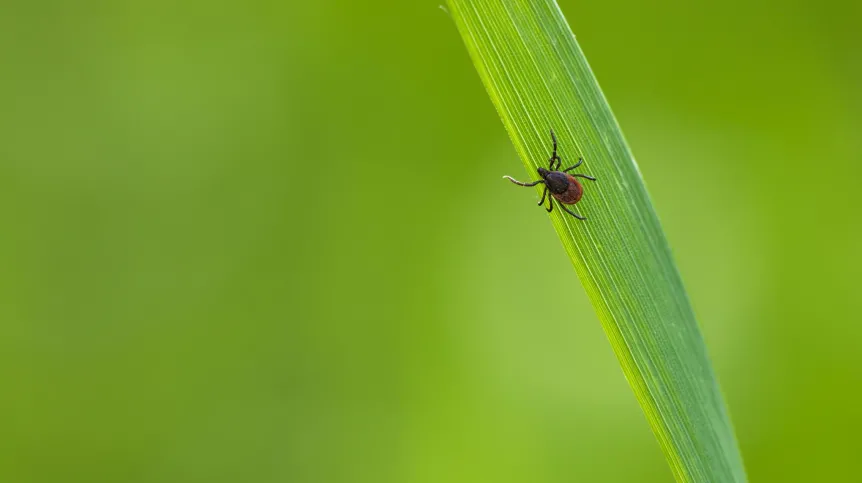
Ticks are not only a problem of forests and meadows. New study by scientists from the University of Warsaw confirms that these parasites are also very common in cities: in parks, botanical gardens, on private properties, and even kindergarten grounds. On top of that, they become active earlier than is commonly believed.
'The idea to investigate the presence of ticks in Warsaw was born from observations and from residents, who increasingly reported cases of bites by these animals in urban locations. We selected several urban and several suburban areas, and it turned out that ticks were present in there in really large numbers', says the first author of the study, Dagmara Wężyk, a doctoral canddate at the Department of Eco-Epidemiology of Parasitic Diseases of the Faculty of Biology, University of Warsaw.
She and her colleagues spent three months (from mid-March to mid-June 2021) conducting systematic tick collections in 15 different locations. They used the flagging method, which involves dragging a white, woolen fabric on the ground and counting the arachnids that attach to it.
'Some collections surprised us, because for example in the Botanical Garden of the University of Warsaw, over a distance of just 20-30 meters, we collected as many as 30 ticks. We recorded equally high numbers in Łazienki Park and in the Forest Kindergarten in the Kabaty Forest', explains the author of the publication in the journal Parasites & Vectors.
Further analysis showed that two species were most common in Warsaw and its surroundings: Ixodes ricinus (the castor bean tick) and Dermacentor reticulatus (the meadow tick). The biologist explains that each of them carries different threats.
The castor bean tick is responsible for transmitting Lyme disease spirochetes (Borrelia burgdorferi) and other dangerous human pathogens, such as tick-borne encephalitis virus and - albeit sporadically - protozoa of the Babesia. genus
In turn, the meadow tick rarely feeds on humans, but poses a serious threat to dogs, because it is the main carrier of the previously mentioned protozoa causing babesiosis, a potentially fatal disease.
Detailed molecular studies revealed that 14.3% of the tested Ixodes ricinus ticks contained DNA of bacteria of the Borrelia, and as many as 64% of Dermacentor reticulatus ticks were carriers of Rickettsia, which cause diseases with symptoms including fever, headaches and rash, and in some cases, serious organ complications.
One of the most important conclusions from the study is the confirmation that the tick season starts earlier than is commonly believed. The meadow tick appears in March, just after temperatures exceed zero degrees Celsius, and it is also active in winter, especially when it is mild. 'That is why we need to take care of protecting our pets against these parasites all year round', Dagmara Wężyk says.
The castor bean tick, on the other hand, starts attacking a few weeks later, reaching its peak activity in May.
'Many people believe that ticks pose the greatest threat between June and September. Meanwhile, our data show that we are exposed from March onwards, and mild winters extend this season even more', the author emphasises.
In her opinion, the collected results clearly show that cities are not much safer in this respect than rural areas. She reminds that some Warsaw locations actually have a higher tick density than suburban areas. The type of habitat is the key factor.
'Ticks love lush vegetation, tall grass, bushes and damp places. That is why there will be many more of them in botanical gardens, parks that are not often mowed, allotment gardens and around water reservoirs. They are rarely found in closely trimmed and very well-kept gardens, pastures, fields or near chicken pens. Mainly due to the small vegetation cover, the lack of a large number of mammals, which are their primary hosts, and the presence of chickens that eat them', she adds.
Interestingly, the study did not reveal any strong correlations between tick density and air temperature or humidity. The impact of these factors turned out to be much smaller than the season and the type of habitat.
The researcher also emphasises that despite the increasing presence of ticks in our environment, we should not panic, but simply be careful. Prevention should be applied early enough, and not only in late spring and summer. Home gardens, especially ones that are overgrown and often watered, can also be checked by 'flagging' from time to time - all you need is a piece of light-coloured fabric and a few minutes of walking on the grass.
If a tick bite does occur, it is crucial to remove the tick quickly. 'First of all, remember that it does not immediately transmit dangerous bacteria to you the moment it bites you. Only a certain percentage of ticks are carriers. In addition, time is important - in the case of Lyme disease spirochetes, the minimum feeding period necessary to infect a human is 24 hours. So if you remove the tick from your body within 24 hours, there is basically no risk of getting sick', Dagmara Wężyk says.
The biologist remains skeptical about the sometimes recommended spraying of properties against ticks. She reminds that although they are indeed effective when it comes to removing these parasites, they also kill other insects and arachnids, whose role in the environment cannot be overestimated.
Katarzyna Czechowicz (PAP)
kap/ zan/ ktl/













